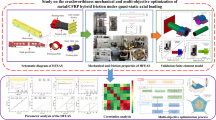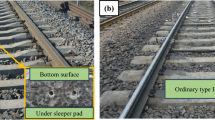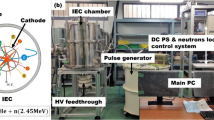Abstract
At present, there are few reports on the application of self-powered ignition system composed of magnet, coil and electric ignition head in small-caliber multi-function ammunition. In this paper, a new type of small-caliber multi-effect penetrator with structure-charge-self-powered integrated ignition is proposed to achieve efficient penetration and internal arson damage for low-small-slow and thin-walled unmanned objects. The high overload generated by the penetration of the penetrator into the target causes the magnet to move at high speed near the coil and induces the induced current to supply the ignition system and then ignite the Al/PTFE active material inside the projectile. In this paper, the force analysis of multi-effect penetrator penetrating thin aluminum plate under different impact velocities and angles (the angle between the normal direction of the target and target plane) is carried out. The numerical simulation of multi-effect penetrator penetrating thin aluminum plate under different impact velocities and angles is performed by ABAQUS/ Explicit software. The influence of gravity on the ignition reliability of self-powered ignition system, impact angle and impact velocity on the penetrating process is analyzed. The results show that the force of the penetrator is uneven in the initial stage of penetration, and the penetrating rate increases fastest in the initial stage of penetration. As the velocity of the penetrator increases, the penetration depth increases, the overload value increases, and the trajectory deflection angle also increases. With the increase in the impact angle, the penetration depth decreases, the overload decreases, and the ballistic deflection angle increases. During the process of oblique penetration, the penetrating angle of the penetrator has a great influence on the movement of the magnet, and a new small-caliber multifunctional penetrator prepared in this work can be used as an anti-UAV equipment to achieve efficient penetration and internal arson damage to the UAV.



















Similar content being viewed by others
Data Availability Statement
The data that support the findings of this study are available from the corresponding author upon reasonable request. This manuscript has associated data in a data repository. [Authors’ comment: …].
References
W. Wang, W. Liu, J. Zou et al., A MEMS safe and arm device for spin stabilized ammunition fuze. Adv. Mater. Res. 403–408, 4593–4597 (2012). https://doi.org/10.4028/www.scientific.net/AMR.403-408.4593
H. Pezous, C. Rossi, M. Sanchez et al., Integration of a MEMS based safe arm and fire device. Sens. Actuators A 159(2), 157–167 (2010). https://doi.org/10.1016/j.sna.2010.03.017
T. Hu, Y. Zhao, Y. Zhao et al., Integration design of a MEMS based fuze. Sens. Actuators A 268, 193–200 (2017). https://doi.org/10.1016/j.sna.2017.09.051
W. Lin, L. Liu, J. Ma. Anti-interference capability evaluation of torpedo fuze based on analytic hierarchy process. International Conference on Electronics, Electrical Engineering and information Science, 2016. https://doi.org/10.1142/9789814740135_0042
L. Liu, F. Cao, Anti-jamming effectiveness evaluation of radio fuze based on the grey analytic hierarchy process. IOP Conf Ser Earth Environ Sci 252, 052125 (2019). https://doi.org/10.1088/1755-1315/252/5/052125
G.H. Haertling, Ferroelectric ceramics: history and technology. J Am Ceramic Soc. (1999). https://doi.org/10.1111/j.1151-2916.1999.tb01840.x
F. Mohammadi, A. Khan, R. Cass, Power generation from piezoelectric lead zirconate titanate fiber composites. Mrs Online Proceedings Library Archive, 736 (2002). https://doi.org/10.1557/PROC-736-D5.5
C. Keawboonchuay, T. Engel, Maximum power generation in a piezoelectric pulse generator. IEEE Trans. Plasma Sci. 31(1), 123–128 (2003). https://doi.org/10.1109/TPS.2003.808874
C. Keawboonchuay, T. Engel, Factors affecting maximum power generation in a piezoelectric pulse generator. IEEE Int. Pulsed Power Conf. IEEE (2003). https://doi.org/10.1109/PPC.2003.1277721
P. Lysne, C. Percival, Electric energy generation by shock compression of ferroelectric ceramics: normalmode response of PZT 95/5. J. Appl. Phys. 46(4), 1519–1525 (1975). https://doi.org/10.1063/1.321803
R. Wang, E. Tang, G. Yang et al., Experimental research of electrical output characteristics of stacked PZT-5H under high-overload conditions. J. Electron. Mater. (2019). https://doi.org/10.1007/s11664-019-06954-9
W. Hawkins, D. Merhar, Propellant pressure-initiated piezoelectric power supply for an impact-delay projectile base-mounted fuze assembly. US, US5092243 A. (1992)
J. Rastegar, R. Murray, C. Pereira, et al. Piezoelectric-based energy-harvesting power sources for gun-fired munitions. Smart Structures and Materials. International Society for Optics and Photonics (2006). https://doi.org/10.1117/12.657441
J. Rastegar, D. Feng, C. Pereira, Piezoelectric-based event sensing and energy-harvesting power sources for thermal battery initiation in gun-fired munitions. SPIE Sens. Technol Appl (2014). https://doi.org/10.1117/12.2053205
D. Segal, I. Bransky, Testing of a piezoelectric generator for in-flight electrical powering of projectile guidance systems. Ferroelectrics 202(1), 81–85 (1997). https://doi.org/10.1080/00150199708213463
Z. Xuefeng, A detailed explanation of multipurpose high explosive tracer bomb M830A1. Mod Weapons 04, 44–45 (2009)
J.C. Keefe, T. Tiernan, M. Connors, et al. Disruptive technologies: achieving the asymmetric edge on the battlefield (WSTIAC) Quarterly. Volume 7, Number 4, December 31, (2007)
H.E. Rui, B.I. Zhong’an, M.E.N.G. Zhaofu, Analysis on the development status of 120 mm tank gun ammunition. Foreign Tanks 1, 42–45 (2015)
A.G. Rheinmetall, Rheinmetall: comprehensive competence in weapon systems and ammunition (2014)
J. Zhang, H. Wang, Y. Zheng et al., Lateral enhancement effect of reactive PELE: two-step segmented simulation and analytical modeling. Thin-Walled Struct 192, 111204 (2023)
Y. Jianping, L. Yakun, W. Zhijun et al., Formation and penetration of PELE/EFP multi-mode warhead based on double-layer shaped charge. J. Energy Mater. 41(1), 4–26 (2023)
Q.Z. Xu, J.P. Yin, Z.J. Wang et al., Effect of a liner material on the formation of the wrap** explosively-formed penetrator. Strength Mater. 50, 54–62 (2018)
Y. Yu, X. Wang, W. Ren, et al. Fragmentation characteristics of 12.7 mm armor-piercing incendiary projectile and ceramic/metal composite target during penetration. Acta Armamentarii, 43(9), 2307 (2022)
E. Tang, Z. He, C. Chen et al., Characterization of dynamic compressive strength and impact release energy of Al/PTFE energetic materials reinforced by aluminum honeycomb skeleton. Compos. Struct. 241, 112063 (2020)
R. Wang, G. Zhao, Projectile end effect. Beijing Institute of Technology Press (1993)
I.A. Kozlitin, A mathematical model of the motion of a spinning projectile. Math. Models Comput. Simul. 13, 80–90 (2021)
F. Luo, B. Zhao, J. Yao, Numerical simulation of Cu particles impacting on medium steel in laser-assisted cold spraying. Acta Armamentarii. 36(11), 2157–2163 (2015)
R. Wang, E. Tang, G. Yang et al., Experimental simulation of self-powered overload igniter based on lead zirconate titanate. Sens Actuators -A Phys 314, 112222 (2020)
L. Wang, Stress wave foundation. National Defense Industry Press (2005)
Acknowledgements
The authors would like to acknowledge National Natural Science Foundation of China (Grant No. 11472178), Foundation for the basic strengthening plan of the science and Technology Commission of the Central Military Commission (2020-JCJQ-JJ-xxxx), and Open Foundation of National key Laboratory of Shock Wave and Detonation Physics (2021JCJQLB05709) to provide fund for conducting experiments.
Author information
Authors and Affiliations
Corresponding authors
Ethics declarations
Conflict of interest
The authors declare that they have no conflict of interest.
Rights and permissions
Springer Nature or its licensor (e.g. a society or other partner) holds exclusive rights to this article under a publishing agreement with the author(s) or other rightsholder(s); author self-archiving of the accepted manuscript version of this article is solely governed by the terms of such publishing agreement and applicable law.
About this article
Cite this article
Tang, E., Cao, Q., Wang, R. et al. Penetration and ignition of new magnetoelectric self-powered small-caliber multi-effect penetrator obliquely impacting aluminum target. Eur. Phys. J. Plus 139, 72 (2024). https://doi.org/10.1140/epjp/s13360-024-04854-4
Received:
Accepted:
Published:
DOI: https://doi.org/10.1140/epjp/s13360-024-04854-4




